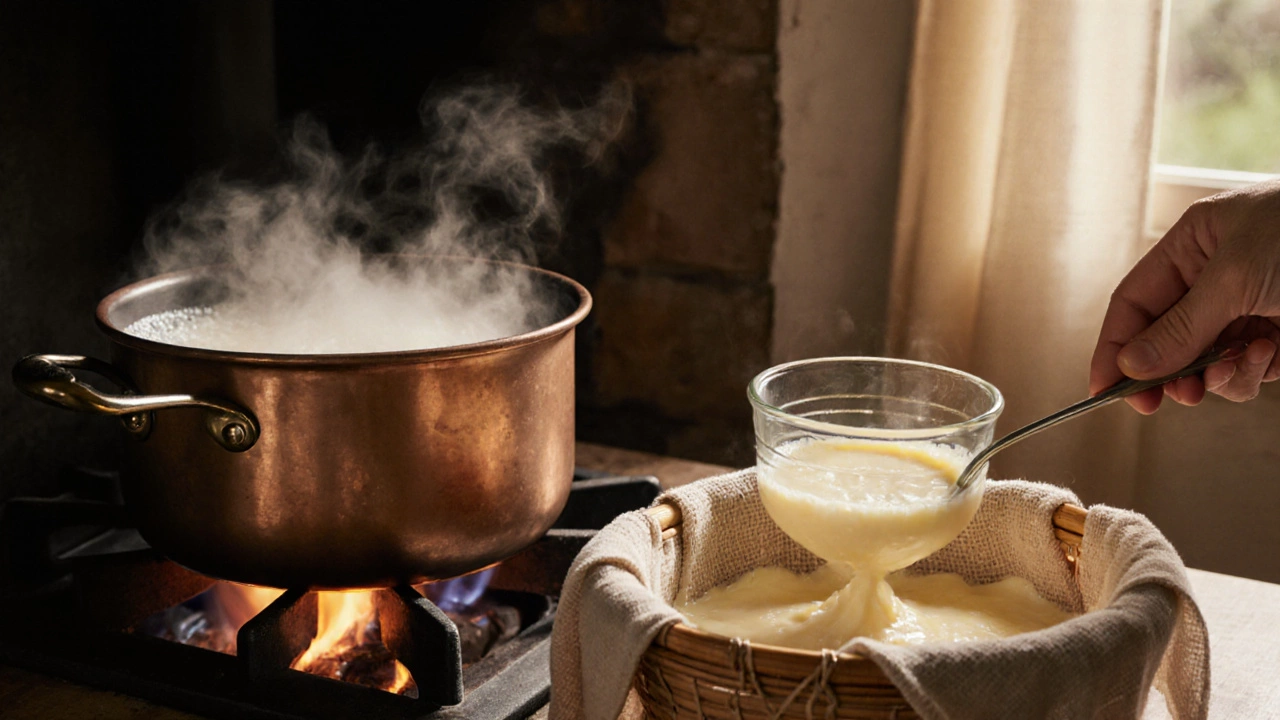
Tiramisu Ingredient Calculator
Make Your Tiramisu
Ingredients Needed
Enter the number of servings to see your ingredient list.
Mascarpone is key: This calculator uses the 45-55% butterfat content of authentic mascarpone. Substitute with other cheeses will alter texture and richness, as explained in our article.
Ever wondered where that silky mascarpone cheese origin story begins? Below we trace the journey of Italy’s most indulgent dairy, from humble Alpine farms to the beloved tiramisu layer that crowns countless desserts.
From Alpine Pastures to the Creamy Dream
Mascarpone cheese is a fresh, high‑fat Italian cheese made by gently heating cream and adding an acid to thicken it. Its name likely derives from the Lombard word mascherpa, meaning “to hide” - a hint that the cheese was once a secret treasure of local dairy makers. The earliest written record appears in a 16th‑century manuscript from Lombardy, the fertile plain south of the Alps. Scholars believe monks in the Cremona area first drafted the recipe, using surplus cream that would otherwise spoil.
Why Cremona Became the Birthplace
The city of Cremona sits on the Po River, a natural artery for dairy trade. In the 1500s, the region’s dairy farms produced copious amounts of cream from both cow and buffalo milk. When the summer heat threatened the freshness of the cream, cheese‑makers experimented with gentle heating and acidification, inadvertently creating the smooth curd we now know as mascarpone.
How the Classic Recipe Works
Traditional mascarpone is made in three simple steps:
- Heat heavy cream (at least 35% fat) to about 85 °C (185 °F). The high fat content prevents curdling.
- Add a small amount of food‑grade acid - typically lemon juice or tartaric acid - and stir gently. The acid causes the cream proteins to coagulate, forming a soft curd.
- Let the mixture sit for 20‑30 minutes, then carefully drain it through a cheesecloth-lined basket. The resulting thickened milk solid is the mascarpone.
Modern producers often replace the acid with calcium‑chloride or rennet for tighter texture, but the core principle stays the same: gentle heat, high‑fat dairy, and a touch of acidity.

Mascarpone Meets Tiramisu
Fast forward to post‑World‑War‑II Italy, when a clever baker in Treviso mixed the cream cheese with egg yolks, sugar, and a splash of Marsala wine. The result? A light yet rich filling that could soak up coffee‑soaked ladyfingers without turning soggy. That dessert, now known worldwide as tiramisu, quickly became a show‑stopper on restaurant menus, thanks in large part to mascarpone’s buttery mouthfeel.
Why did mascarpone win over other candidates like ricotta or cream cheese? Three reasons:
- Fat content: With 45-55% butterfat, mascarpone creates a silky mouthfeel that feels luxurious, but it still spreads easily.
- Neutral flavor: Unlike ricotta’s grainy texture or cream cheese’s tang, mascarpoon’s mild, slightly sweet taste lets coffee, cocoa, and liqueur shine.
- Stability: The curd holds up when layered, preventing the dessert from collapsing after a few hours in the fridge.
Beyond Tiramisu: Modern Uses
Today, chefs use mascarpone in sweet and savory dishes alike. Think:
- Swirled into fruit‑based parfaits for a creamy lift.
- Folded into risotto for an ultra‑rich finish.
- Blended with herbs to craft a delicate spread for crostini.
- Whipped with powdered sugar to top pumpkin pies, cheesecakes, or even pizza.
Because the cheese contains very little protein, it behaves more like a thickened cream than a traditional cheese, making it highly adaptable.
Common Myths Debunked
Myth #1: Mascarpone is just “Italian cream cheese.”
Fact: While both are fresh cheeses, cream cheese is made from a blend of milk and cream, then cultured and pressed. Mascarpone skips the culturing step, relying solely on heat and acid, resulting in a higher fat content and smoother texture.
Myth #2: You can substitute sour cream one‑for‑one.
Fact: Sour cream’s tang and lower fat make it a poor stand‑in for mascarpone in tiramisu; the dessert would taste sharp and lack that melt‑in‑your‑mouth richness.
Myth #3: Mascarpone always comes from Italy.
Fact: Many artisanal dairies worldwide now produce their own version, especially in the U.S. and Australia, though they must meet the same fat ratio to be labeled “mascarpone.”

Buying, Storing, and Using Tips
When selecting mascarpone, look for a container that feels heavy for its size - that indicates a high butterfat level. The cheese should be creamy, not grainy, and free of any off‑smell.
Store it in the fridge at 4 °C (39 °F) and use within a week of opening. If you need it longer, freeze it in an airtight bag; it will become slightly grainier but still works in cooked dishes.
Before adding to a recipe, let the cheese sit at room temperature for 10-15 minutes. This makes it easier to whisk without lumps, especially when creating the classic tiramisu layer.
Quick Reference: Mascarpone vs. Ricotta vs. Cream Cheese
| Attribute | Mascarpone | Ricotta | Cream Cheese |
|---|---|---|---|
| Primary dairy base | Heavy cream | Whey (cow milk) | Milk & cream blend |
| Butterfat % | 45-55% | ~10% | 33% |
| Texture | Silky, spreadable | Grainy, slightly curdy | Firm yet spreadable |
| Typical uses | Tiramisu, desserts, sauces | Stuffings, pastries | Bagels, cheesecakes |
| Acidification method | Added acid (lemon, tartaric) | Heat & whey proteins | Culture & rennet |
Frequently Asked Questions
What is the literal meaning of "mascarpone"?
The name likely comes from the Lombard word mascherpa, meaning “to hide” or “to cover,” referring to how the cheese can mask or enrich other flavors.
Can I make mascarpone at home without special equipment?
Absolutely. All you need is heavy cream, a food‑grade acid like lemon juice, a thermometer, and a fine‑mesh cheesecloth. The process takes less than an hour.
Is mascarpone safe for people with lactose intolerance?
Mascarpone is still a dairy product, so it contains lactose. However, its high fat content means the lactose concentration is lower than in milk. Those with severe intolerance should still avoid it.
How long does opened mascarpone keep in the fridge?
Once opened, aim to use it within 7‑10 days. Keep it sealed tightly and store it in the coldest part of the refrigerator.
Can I substitute mascarpone with Greek yogurt in tiramisu?
Greek yogurt will give you a tangy, lighter texture, but it won’t deliver the signature richness of tiramisu. If you need a lower‑fat option, try a 1:1 mix of Greek yogurt and a splash of heavy cream.
Now you’ve got the full backstory, the science, and the practical tips to enjoy mascarpone any way you like. Whether you’re layering it in a classic tiramisu or whisking it into a savory sauce, you’re handling a cheese with a history as rich as its flavor.





